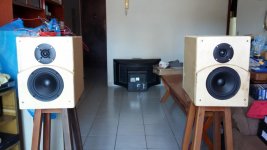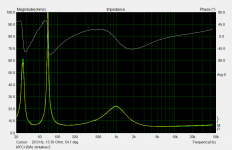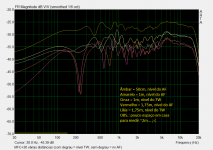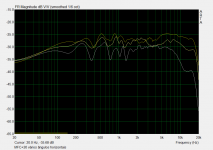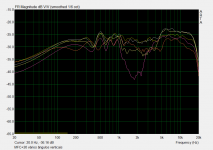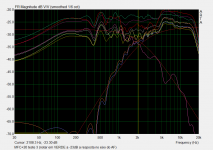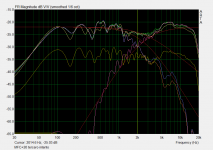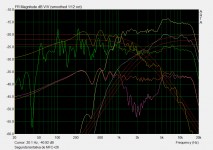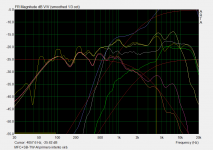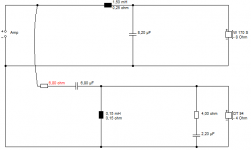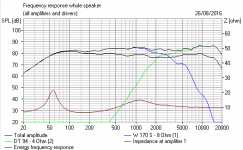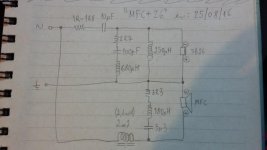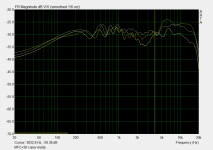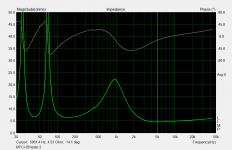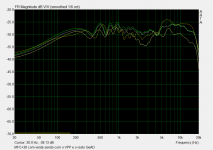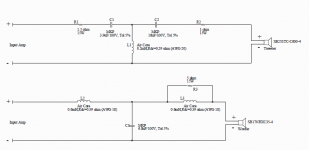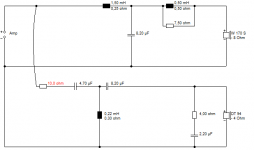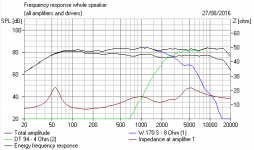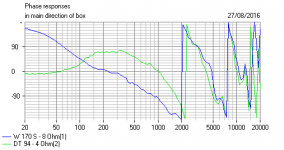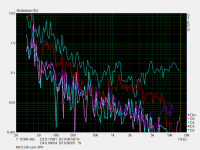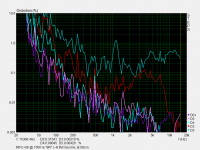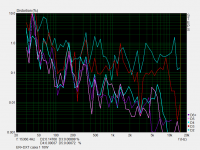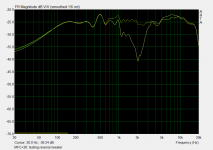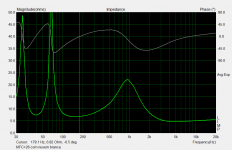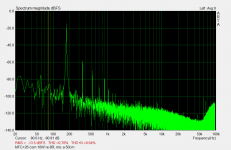Hello fellows from DIYAudio,
Oh... my first thread, after one year of participation here
Here is my new construction using polypropylene cone speaker and aluminum tweeter of the SB Acoustics. This is not anything new. Designers like Troels Gravesen have done their versions.
This project was born of a need and a curiosity: I was curious to know the results so acclamed about the high Qm speakers***, and so I chosen this SBA. Also chosen why I had not yet experienced playing with polypropylene speakers, and maybe it was the kind of sound I was looking for ...
I already had a pre-assembled box, only missing the front. Time to apply the speakers! I decided to imitate Troels using stepped baffle and LR-2 crossover. The point is that Troels no longer publishes the crossovers values, and rightly so, given the circumstances that occurred to him. And their project do not match 100% with my project, which differ in dimensions. Time to learn more about crossovers!
Soon I publish some measurements and the resulting crossover after some iterations. But I advise here: I'm a newbie about acoustical measurements, and my apartment is small, so everything below 1kHz or so is a disaster...
 but at least the cross point is higher than that.
but at least the cross point is higher than that.
And is a working in progress: if knowledge permits, some refinements are in order
***but I have much fear about power compression, due to lack of the inherent "heatsink" in this fiberglass former, in comparision with the more common aluminium VC former.
Oh... my first thread, after one year of participation here
Here is my new construction using polypropylene cone speaker and aluminum tweeter of the SB Acoustics. This is not anything new. Designers like Troels Gravesen have done their versions.
This project was born of a need and a curiosity: I was curious to know the results so acclamed about the high Qm speakers***, and so I chosen this SBA. Also chosen why I had not yet experienced playing with polypropylene speakers, and maybe it was the kind of sound I was looking for ...
I already had a pre-assembled box, only missing the front. Time to apply the speakers! I decided to imitate Troels using stepped baffle and LR-2 crossover. The point is that Troels no longer publishes the crossovers values, and rightly so, given the circumstances that occurred to him. And their project do not match 100% with my project, which differ in dimensions. Time to learn more about crossovers!
Soon I publish some measurements and the resulting crossover after some iterations. But I advise here: I'm a newbie about acoustical measurements, and my apartment is small, so everything below 1kHz or so is a disaster...
And is a working in progress: if knowledge permits, some refinements are in order
***but I have much fear about power compression, due to lack of the inherent "heatsink" in this fiberglass former, in comparision with the more common aluminium VC former.
Attachments
Last edited:
Some measurements, starting with the resulting impedance
The box is ported but at moment I have at work and don't remember the resulting dimensions.
Interesting is: the crossover point is 2.5kHz, but the impedance hump occurs at 1kHz (well, several projects have same resulting Z, anyway...)
The box is ported but at moment I have at work and don't remember the resulting dimensions.
Interesting is: the crossover point is 2.5kHz, but the impedance hump occurs at 1kHz (well, several projects have same resulting Z, anyway...)
Attachments
WARNING  : Some acoustical measurements, for some tries
: Some acoustical measurements, for some tries
"Almost all" using 1/6dB smooting and some 6~7ms gating
For the 7th figure (last figure), with portuguese inscriptions, note the higher measurement, is the most flat response I can obtain until today. +/-3dB or so from midrange up is not tooo bad, but is only at WOOFER axis ("nível do AF"). At this point, the midrange/low treble response with most music are basically neutral.
For the 5th figure, various vertical angles. Maybe the cross point are not yet well matched, since the vertical response changes too much (even considering the stepped baffle, I think). maybe need some refinement.
For the 6th figure, is to check the horizontal dispersion. The purple/blue (what a color...) is a extreme angle, so the tweeter HF suffers, but obviously the cross response is OK here (relative to not change with angle).
The first other figures are the first attempts, and I love to use too much the overlays


 Some show the attempts to match the desired response per driver/to match the L-R 2 target.
Some show the attempts to match the desired response per driver/to match the L-R 2 target.
Since this is work at progress, tomorrow will have some new measurements, including HD sweep
"Almost all" using 1/6dB smooting and some 6~7ms gating
For the 7th figure (last figure), with portuguese inscriptions, note the higher measurement, is the most flat response I can obtain until today. +/-3dB or so from midrange up is not tooo bad, but is only at WOOFER axis ("nível do AF"). At this point, the midrange/low treble response with most music are basically neutral.
For the 5th figure, various vertical angles. Maybe the cross point are not yet well matched, since the vertical response changes too much (even considering the stepped baffle, I think). maybe need some refinement.
For the 6th figure, is to check the horizontal dispersion. The purple/blue (what a color...) is a extreme angle, so the tweeter HF suffers, but obviously the cross response is OK here (relative to not change with angle).
The first other figures are the first attempts, and I love to use too much the overlays


Since this is work at progress, tomorrow will have some new measurements, including HD sweep
Attachments
Last edited:
About the "polemical" thing, the sound...
Like I said, is well balanced at woofer axis. And respectable outside that, but maybe some refinement is required.
But I don't noted sooo much difference in "resolution" (relative to high-Qm fame), instead I noted since first time a strong, more "resonant" bass, if compared, for example, with the Mark K ER18+DXT. In MarkK the bass is more lean but more true to original (this from memory; the MarkK-based is with a friend now). In these SB, the bass is more perceptible but have a little tendency to booming. Of course, very different drivers, but here is the results.
In fact, is fun to listen bass-heavy in these SB, like some electronic, reggae, and "bass noise disc testers". You can listen easily 36Hz notes even without EQ and with electronic music with strong vocals and midrange content etc.
About my results with ER18+DXT, see: http://www.diyaudio.com/forums/multi-way/157595-mark-ks-er18dxt-12.html
Like I said, is well balanced at woofer axis. And respectable outside that, but maybe some refinement is required.
But I don't noted sooo much difference in "resolution" (relative to high-Qm fame), instead I noted since first time a strong, more "resonant" bass, if compared, for example, with the Mark K ER18+DXT. In MarkK the bass is more lean but more true to original (this from memory; the MarkK-based is with a friend now). In these SB, the bass is more perceptible but have a little tendency to booming. Of course, very different drivers, but here is the results.
In fact, is fun to listen bass-heavy in these SB, like some electronic, reggae, and "bass noise disc testers". You can listen easily 36Hz notes even without EQ and with electronic music with strong vocals and midrange content etc.
About my results with ER18+DXT, see: http://www.diyaudio.com/forums/multi-way/157595-mark-ks-er18dxt-12.html
Last edited:
I saw this project: SBAcoustics-61-MFC
It's a fairly useless low inductance polycone, IMO. Most 6" polycones rolloff faster, and don't have all that hash around 6kHz!
Makes hard work with crossover, especially time-aligned, where LCR (What? 3.9uF/0.2mH/2.2R for 6 kHz?) notches don't work so well. Maybe a ca. 0.5mH coil after the shunt in the bass filter, third order would help?
I found the quick and dirty crossover looked OK. I think I'd start there. Just don't know if the 6kHz breakup will be annoying. I didn't get reverse polarity on the tweeter for some reason. I added a Zobel, because metal tweeters sound better with them IMO.
I don't like this one, TBH. It seems to all work better on flat baffle.
It's a fairly useless low inductance polycone, IMO. Most 6" polycones rolloff faster, and don't have all that hash around 6kHz!
Makes hard work with crossover, especially time-aligned, where LCR (What? 3.9uF/0.2mH/2.2R for 6 kHz?) notches don't work so well. Maybe a ca. 0.5mH coil after the shunt in the bass filter, third order would help?
I found the quick and dirty crossover looked OK. I think I'd start there. Just don't know if the 6kHz breakup will be annoying. I didn't get reverse polarity on the tweeter for some reason. I added a Zobel, because metal tweeters sound better with them IMO.
I don't like this one, TBH. It seems to all work better on flat baffle.
Attachments
http://www.diyaudio.com/forums/multi-way/295732-sb-acoustics-sb17nac35-4-measurements.html
In fact, the poly version is not better than the metal version... for some, is worse
for some, is worse
system7, I considered using another crossover order, and cut the tweeter lower, but the temptation to get the LR2 was big (and to experiment with stepped baffle). Personally I'm about to give up the decision, because the response does not behave well at vertical, although the end user of this box (which is a friend of mine) is already amazed with the current results. For him I already declare terminated the project. He is used to listen mini-systems and micro-systems, and this is already a revelation for him. And for serious listening, the window is comfortable large (far larger than full ranges, for example).
By the way, at this time will be difficult to change the box front, so I'm stuck with stepped baffle...
Follow the resulting crossover, for now. The component quantity is based on Troels project
 . The tweeter notch is made oversized, to cut down the response at tweeter resonance (is awful sounding) and to match the 100µF elcap.
. The tweeter notch is made oversized, to cut down the response at tweeter resonance (is awful sounding) and to match the 100µF elcap.
By the way, even the Troels solution has some response anomaly near cross point.
I don't used speaker crossover simulator to obtain the values. I played with component values, starting from some other LR2 projects, and arrived here.
A remark about vertical response: It gets worse as it rises above the tweeter level, and not much worse towards the speaker down. My preferred solution? Use the box upside down! Is easier than try to mess with crossover...
Is easier than try to mess with crossover... But results ugly aesthetically...
But results ugly aesthetically...  Or use a stand to match the woofer a little higher than ear level.
Or use a stand to match the woofer a little higher than ear level.
In fact, the poly version is not better than the metal version...
system7, I considered using another crossover order, and cut the tweeter lower, but the temptation to get the LR2 was big (and to experiment with stepped baffle). Personally I'm about to give up the decision, because the response does not behave well at vertical, although the end user of this box (which is a friend of mine) is already amazed with the current results. For him I already declare terminated the project. He is used to listen mini-systems and micro-systems, and this is already a revelation for him. And for serious listening, the window is comfortable large (far larger than full ranges, for example).
By the way, at this time will be difficult to change the box front, so I'm stuck with stepped baffle...
Follow the resulting crossover, for now. The component quantity is based on Troels project
 . The tweeter notch is made oversized, to cut down the response at tweeter resonance (is awful sounding) and to match the 100µF elcap.
. The tweeter notch is made oversized, to cut down the response at tweeter resonance (is awful sounding) and to match the 100µF elcap.By the way, even the Troels solution has some response anomaly near cross point.
I don't used speaker crossover simulator to obtain the values. I played with component values, starting from some other LR2 projects, and arrived here.
A remark about vertical response: It gets worse as it rises above the tweeter level, and not much worse towards the speaker down. My preferred solution? Use the box upside down!
 Or use a stand to match the woofer a little higher than ear level.
Or use a stand to match the woofer a little higher than ear level.Attachments
Last edited:
Some measurements with box upside down  only to confirm the inversion of low/high vertical response (not noted in graph, but confirmed in practice)
only to confirm the inversion of low/high vertical response (not noted in graph, but confirmed in practice)
The resulting actual crossover Z, with some zoom. Note some glitch at near 400Hz; maybe need more stuffing
The HD stepping with 2.83V. For sure that SB distorts more than the Seas ER18 in bass department (now I need to find my ER18+DXT measurements...)
The resulting actual crossover Z, with some zoom. Note some glitch at near 400Hz; maybe need more stuffing
The HD stepping with 2.83V. For sure that SB distorts more than the Seas ER18 in bass department (now I need to find my ER18+DXT measurements...)
Attachments
I've never liked second order with 6" bass. You can't get steep slopes on the bass, and so you hear breakup IMO.
I was looking at SB Acoustics EKA design, below. Add 18mm offset for time alignment, tweeter recess, by all accounts, which seems about what Troels and you did.
4 ohm NRX woofer: 6" SB17NRXC35-4 :: SB Acoustics
8 ohm bassier but less efficient MFC woofer with far less breakup: 6" SB17MFC35-8 :: SB Acoustics
Anyway, it's the design that seems to line up phase nicely. It's third order in effect, but phase aligned. I like the look of it. Conversion to 8 ohm is just a question of adding 50% or so to coils and resistors, and reducing caps by a third. My own sim slightly disagreed, but I was using a higher inductance bass.
But what's not to like? 25dB down at 5kHz electrically, so no nasty breakups. Sort of thing I'd build and tune by ear. Tweeter level particularly. 10 ohms seems a lot! I'd suspect it could be smaller. But it's near enough the old KEF tweeter filter adjusted to 4 ohms.
So, IMO, this EKA filter is the right concept here. Just needs tuning. See with low inductance bass, you often add back some inductance and it then behaves like high inductance with second order to give you overall third order.
I was looking at SB Acoustics EKA design, below. Add 18mm offset for time alignment, tweeter recess, by all accounts, which seems about what Troels and you did.
4 ohm NRX woofer: 6" SB17NRXC35-4 :: SB Acoustics
8 ohm bassier but less efficient MFC woofer with far less breakup: 6" SB17MFC35-8 :: SB Acoustics
Anyway, it's the design that seems to line up phase nicely. It's third order in effect, but phase aligned. I like the look of it. Conversion to 8 ohm is just a question of adding 50% or so to coils and resistors, and reducing caps by a third. My own sim slightly disagreed, but I was using a higher inductance bass.
But what's not to like? 25dB down at 5kHz electrically, so no nasty breakups. Sort of thing I'd build and tune by ear. Tweeter level particularly. 10 ohms seems a lot! I'd suspect it could be smaller. But it's near enough the old KEF tweeter filter adjusted to 4 ohms.
So, IMO, this EKA filter is the right concept here. Just needs tuning. See with low inductance bass, you often add back some inductance and it then behaves like high inductance with second order to give you overall third order.
Attachments
Last edited:
OOPS; ERRATA: the last graph are not the HD sweep. Here is it:Some measurements with box upside downonly to confirm the inversion of low/high vertical response (not noted in graph, but confirmed in practice)
The resulting actual crossover Z, with some zoom. Note some glitch at near 400Hz; maybe need more stuffing
The HD stepping with 2.83V. For sure that SB distorts more than the Seas ER18 in bass department (now I need to find my ER18+DXT measurements...)
Is not bad; in fact, at this power level, the higher-order HD from midrange up is almost absent. And sounds smooth and "round". Comparing with some others measurements I have made, this is a good result. Even the ER18+DXT have more high order grunge than this (except in bass department).
Attachments
Last edited:
Very interesting propositions! And I like the "external" coil, since most speakers varies the inductance with displacement, even this MFC/NRX/NAC line (the Satori varies almost none). So is good to put it out of equation, or reduce the contributions magnitude. By the way, the VC inductance value is not a guarantee of linearity: The JA-8008 I have in Troels TQWT have almost zero inductance change, measured by John from Zaph Audio, despite high VC inductance.I've never liked second order with 6" bass. You can't get steep slopes on the bass, and so you hear breakup IMO.
I was looking at SB Acoustics EKA design, below. Add 18mm offset for time alignment, tweeter recess, by all accounts, which seems about what Troels and you did.
4 ohm NRX woofer: 6" SB17NRXC35-4 :: SB Acoustics
8 ohm bassier but less efficient MFC woofer with far less breakup: 6" SB17MFC35-8 :: SB Acoustics
Anyway, it's the design that seems to line up phase nicely. It's third order in effect, but phase aligned. I like the look of it. Conversion to 8 ohm is just a question of adding 50% or so to coils and resistors, and reducing caps by a third. My own sim slightly disagreed, but I was using a higher inductance bass.
But what's not to like? 25dB down at 5kHz electrically, so no nasty breakups. Sort of thing I'd build and tune by ear. Tweeter level particularly. 10 ohms seems a lot! I'd suspect it could be smaller. But it's near enough the old KEF tweeter filter adjusted to 4 ohms.
So, IMO, this EKA filter is the right concept here. Just needs tuning. See with low inductance bass, you often add back some inductance and it then behaves like high inductance with second order to give you overall third order.
Talking about cone break-up, even with this original strange woofer response, the MFC break-up don't sounds very harsh and seems to be fair hidden even with shallow LR2 filter. I have experienced some woofers with more "beautiful" response with more hash sounding break-up. Go figure...
**LR2 plus some filtering LRC trap**Talking about cone break-up, even with this original strange woofer response, the MFC break-up don't sounds very harsh and seems to be fair hidden even with shallow LR2 filter. I have experienced some woofers with more "beautiful" response with more hash sounding break-up. Go figure...
Now the results for 8.9Vrms (aka. "10W re. 8R") for this project. For most audio band, the higher order harmonics are low to really low, including the aluminium tweeter area. I've included a test with the ER18+DXT (MarkK project) to compare the results. The SBA components seems to be less high order HD than the SEAS components, but in bass department the SEAS has a little advantage.
Please note my homemade DIY "brute" measurements technics, but at least the 2 projects are measured from same methods.
Please note my homemade DIY "brute" measurements technics, but at least the 2 projects are measured from same methods.
Attachments
Now showing the reverse-polarity test for catch the null point. Maybe a point to be perfected.
And the resulting impedance after stuffing the box internals (before have absorbing material only in the walls).
A FFT showing the HD content at some frequency (and shows the low frequency rumble from my living room)
And the resulting impedance after stuffing the box internals (before have absorbing material only in the walls).
A FFT showing the HD content at some frequency (and shows the low frequency rumble from my living room)
Attachments
Phase alignment is overrated, IMO. I say this as a person who does 90 degree phase BW3 as preference which has no significant reverse null at all. The most natural sounding of filters according to some pink-noise listening tests which I might be able to dig up with some effort. 
But you battle on. I have built a dozen filters for my own favourite speakers. Strengths and weaknesses, but I mainly like a flat power response and a flat impedance. Michael Chua did an interesting SEAS ER18RNX 6" here, called the Starling: "STARLING" (Seas 27TDFC + Seas ER18RNX) Bookshelf by AmpsLab
I like the way he separated out the bafflestep with the LR.
BTW, how do you get your drivers and crossover components? Krafty seems to find this difficult in Brazil. Huge import taxes.
But you battle on. I have built a dozen filters for my own favourite speakers. Strengths and weaknesses, but I mainly like a flat power response and a flat impedance. Michael Chua did an interesting SEAS ER18RNX 6" here, called the Starling: "STARLING" (Seas 27TDFC + Seas ER18RNX) Bookshelf by AmpsLab
I like the way he separated out the bafflestep with the LR.
BTW, how do you get your drivers and crossover components? Krafty seems to find this difficult in Brazil. Huge import taxes.
In practice, in Brazil, imports of consumer goods purchased by individuals should always be taxed at 60% (which I think is too high). A while ago, some products passed without charges, either because of the value, either by misjudgment from the Customs. But the most common is the Customs overtaxing the products because they will apply the highest price they can find on the Internet, or guessing that it is another product category.
And the worst is that the goods sometimes can be up to about 3 or 4 months retained in Customs, waiting taxation. A long delay!
This encourages people living in border with other countries trying to order the products in neighboring countries, with friends or store owners of these places.
And also people can "stuck" with the purchased drivers since is a PITA do send back...
And the worst is that the goods sometimes can be up to about 3 or 4 months retained in Customs, waiting taxation. A long delay!
This encourages people living in border with other countries trying to order the products in neighboring countries, with friends or store owners of these places.
And also people can "stuck" with the purchased drivers since is a PITA do send back...
Interesting to know, since the buzzword now is "second order Linkwitz-Riley" crossover for naturality... so in somes cases is another audio myth. And since is easier to make a box without stepped baffle...Phase alignment is overrated, IMO. I say this as a person who does 90 degree phase BW3 as preference which has no significant reverse null at all. The most natural sounding of filters according to some pink-noise listening tests which I might be able to dig up with some effort.
<snip>.
Other thing, is Bessel better or worse than BW for third order (or again, is case-dependent)? A friend of mine have a active 5-way (with a huge horn in the bass, the one in my avatar, but deactivated now
As someone who also prefers BW3, I say this is poor advice. For BW3, phase should be single continuous line falling from top left to bottom right. For LR4(and I believe LR2), the reverse null is very important, or the speaker will not sound right at all.Phase alignment is overrated, IMO. I say this as a person who does 90 degree phase BW3 as preference which has no significant reverse null at all. The most natural sounding of filters according to some pink-noise listening tests which I might be able to dig up with some effort.
I found the reference to crossover order:
http://www.ctc-dr-weber.de/speaker/Audibility%20of%20different%20crossover%20types.pdf
It's hard to quote from a PDF, the formatting goes crazy, but they could hear the hole in power response with LR2 and LR4 off axis, particularly around 2-3kHz crossover where the midbass beams badly. Bessel did OK too, mainly due to the slight 1.25dB peak at crossover.
That is sort of what Lynn Olson did in the famous 5" MTM Ariel, but easier with flat 5" drivers IMO. I've done LR4 (4th order tweeter filter) with my own 8" bass flat baffle two ways, and it's a very clean sound. LR2 is more musically involving, but harsher on breakup and distortion. BW3 seems to sound great off-axis in ANY direction and quite clean. You don't have to toe them in to your ears. And it sounds most natural all around the room.
BW3 is terribly hard to model, but the basic idea might be to time align it, get a +3dB power flat hump at crossover, then muck up the time alignment so phase is near 90 degrees so it has flat FR but retains the good power flatness and response off-axis. It works well with flat baffle and 8" and negative polarity. 5" is doable too. 6" is problematic IMO. 6" is my least favourite speaker. For instance, the SEAS Idunn and Thor kits attract endless moans about tonal balance, so I'm not alone.
http://www.ctc-dr-weber.de/speaker/Audibility%20of%20different%20crossover%20types.pdf
This might come as a shock, but we think that the overall winner was the 3rd order Butterworth filter, which was terribly popular in the 70's and 80's. I think we have heard why that is this case. Another conclusion is that during listening you rapidly gets used to the character of a certain filter. After switching back to the REF, the results can be rather overwhelming, knocking you straight off your feet at times. Even to a point where the REF start sounding... colored!
It's hard to quote from a PDF, the formatting goes crazy, but they could hear the hole in power response with LR2 and LR4 off axis, particularly around 2-3kHz crossover where the midbass beams badly. Bessel did OK too, mainly due to the slight 1.25dB peak at crossover.
Odd order filters came nearer to the REF... except Bess2. We found the following explanation for this: textbook Bess2 (which is what we're talking about) has a hump of nearly 1.25 dB at the xo point. This on-axis excess energy compensates for the loss of power off-axis with this even order filter.
That is sort of what Lynn Olson did in the famous 5" MTM Ariel, but easier with flat 5" drivers IMO. I've done LR4 (4th order tweeter filter) with my own 8" bass flat baffle two ways, and it's a very clean sound. LR2 is more musically involving, but harsher on breakup and distortion. BW3 seems to sound great off-axis in ANY direction and quite clean. You don't have to toe them in to your ears. And it sounds most natural all around the room.
BW3 is terribly hard to model, but the basic idea might be to time align it, get a +3dB power flat hump at crossover, then muck up the time alignment so phase is near 90 degrees so it has flat FR but retains the good power flatness and response off-axis. It works well with flat baffle and 8" and negative polarity. 5" is doable too. 6" is problematic IMO. 6" is my least favourite speaker. For instance, the SEAS Idunn and Thor kits attract endless moans about tonal balance, so I'm not alone.
A update...
For brave folks following

Since I've listened for various months, here is the "sober" evaluation. Starting with pros and cons, with comnparisions:
PROS:
**midrange+treble to die for... very neutral, very natural, detailed and not fatiging. In fact, is difficult do end the listening session.
**Low HD in midrange and treble area. Good response and fair-to-good dispersion (poor in one axis)
**Good in the "DDR" area, ie, in live recordings, is possible to liste the public even with musics playing, like a good headphone (but Stax eat it for breakfast)
**I liked very much this tweeter. I prefer it to various models costing much more.
Comparisions: is more detailed than JA-8008, but JA-8808 is a different animal with much more bass capability (make sure to read the CONS )
)
Seems to be more musical, less fatiging and more "neutral" than MarkK project, but it can be my tastes
CONS:
**"strange" bass. What?! Well, the perceived bass response is good, but the HD is very high. Muddy sound if recording is bass heavy (intermodulation). Better to use it like a midbass... I've read in some site a Klippel result with a mere 1.9mm for a linear Xmax from suspension, so I can imagine this suspension optimized for midrange only...
In this regards, the SEAS ER18 is very better, rivalling some 8" in bass linearity!
**Need to use a notch filter is not very funny, but is easy in this driver.
**Low tweeter efficiency.
For brave folks following
Since I've listened for various months, here is the "sober" evaluation. Starting with pros and cons, with comnparisions:
PROS:
**midrange+treble to die for... very neutral, very natural, detailed and not fatiging. In fact, is difficult do end the listening session.
**Low HD in midrange and treble area. Good response and fair-to-good dispersion (poor in one axis)
**Good in the "DDR" area, ie, in live recordings, is possible to liste the public even with musics playing, like a good headphone (but Stax eat it for breakfast)
**I liked very much this tweeter. I prefer it to various models costing much more.
Comparisions: is more detailed than JA-8008, but JA-8808 is a different animal with much more bass capability (make sure to read the CONS
Seems to be more musical, less fatiging and more "neutral" than MarkK project, but it can be my tastes
CONS:
**"strange" bass. What?! Well, the perceived bass response is good, but the HD is very high. Muddy sound if recording is bass heavy (intermodulation). Better to use it like a midbass... I've read in some site a Klippel result with a mere 1.9mm for a linear Xmax from suspension, so I can imagine this suspension optimized for midrange only...
In this regards, the SEAS ER18 is very better, rivalling some 8" in bass linearity!
**Need to use a notch filter is not very funny, but is easy in this driver.
**Low tweeter efficiency.
- Status
- This old topic is closed. If you want to reopen this topic, contact a moderator using the "Report Post" button.
- Home
- Loudspeakers
- Multi-Way
- Yet another 6+1 construction: SB17MFC35-8 + SB26ADC-C000-4
